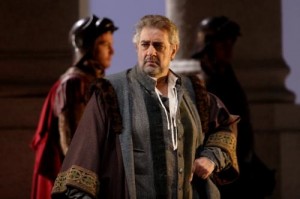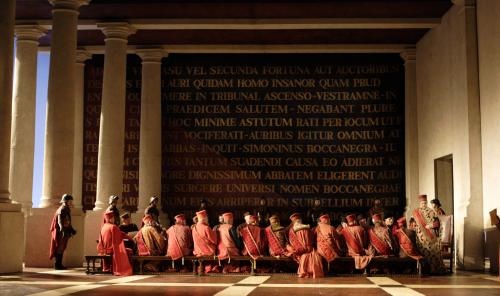Cultural Cocktail Hour
Review: Simon Boccanegra at LA Opera- a MUST-SEE Production
Review: LA Opera’s Simon BoccanegraA Night of Dignity and Gloryby
Leticia Marie Sanchez
©2012
Director Elijah Moshinsky’s Simon Boccanegra, now on stage at LA Opera, was originally created in 1991 for the Royal Opera House, Covent Garden and exudes majesty and dignity. The plebians, the ninety-nine percent movement in fourteenth-century Genoa, want to occupy the Doge’s palace and remove the patricians from power through the corsair hero of the masses, Simon Boccanegra. Moshinsky’s glorious production does not use any gimmicks or flash. Instead, through his elegant reverence for history and a beautifully refined set, the music and characters come to the forefront of the opera, riveting the audience as does Plácido Domingo in the title role.
Even before Simon Boccanegra begins, a blue impressionist screen sets the stage, alluding to the oceans conquered by the pirate hero of Giuseppe Verdi’s opera, (our English word for buccaneer derives from Boccanegra). Seductive sea currents literally flow on stage while James Conlon conducts the orchestra, evoking Debussy-like waves. Simon Boccanegra represents a deeply personal memory for Conlon, and his conducting on opening night honored that memory. In a podcast interview on LA Opera’s website, Conlon revealed that watching Giorgio Strehler’s production of Simon Boccanegra as a youth so moved him that it became his favorite recollection of an opera production. Conlon did justice to that defining moment by shaping Saturday evening’s music into a dynamic character. For instance, when Boccanegra reaches for a poison-filled chalice in Act II, ominous strains of the strings hint at the nefarious culprit, who is not on stage. As the strings evoke the villain, a woman in the audience gasped, “Paolo.”
Michael Yeargan‘s sets poetically captured the themes of the opera. Black and white tiles adorned the stage floor, a metaphorical chessboard for the power plays in fourteenth-century Genoa. The first act takes the audience inside a striking hall of Doric columns whose heightened perspective makes us feel like we are stepping into a Brunelleschi-designed colonnade. In the last scene, a stark blue square, like an azure Rothko framed by Doric columns, hearkens back to the blue screen at the prologue, fittingly, as Boccanegra has gone full circle and sings of his memories.
Duane Schuler’s lyrical lighting envelops the audience in the darkened ambiance of political intrigue. Shadows herald the tragic death of Simon’s lover, Maria. In contrast, during the fortuitous entrance of his daughter Amelia (in which she prevents her beloved father from stabbing), a golden splash of lights illuminates the darkened columns. We can see and feel that Amelia is her father’s sunshine. The interplay between shadows and light underscore the emotional heart of Verdi’s opera.
The dark motifs blend seamlessly with the voices in this opera, the low voices of bass (Vitalij Kowaljow as Fiesco) and baritone. Plácido Domingo, renown for his prowess as a tenor, emerges triumphant in the baritone role of Simon Boccanegra. His voice radiates in the lower tessitura and he infuses the role of the Doge with equal measures of dignity and tenderness, particularly for his daughter wonderfully portrayed by Ana María Martínez. Although Ms. Martínez has sung with Mr. Domingo in other venues and has been conducted at LA Opera by the maestro, this production marks the first time that they have sung together on the LA Opera stage. A 1995 winner of the Operalia World Opera Competition, founded by Mr. Domingo, Ms. Martínez’s cascading soprano sound contrasts brilliantly with Domingo’s burnished baritone at the end of Act I, (“Figlia! a tal nome io palpito) when she sings “I will be your dove of peace.” Italian Baritone Paolo Gavanelli flourishes in the role of the Karl-Rove-like mastermind (“You owe your thrown to me”) Paolo, and tenor Stefano Secco embodies the jealous young lover, Gabriele Adorno. One of the most powerful moments in the opera was the trio between Adorno, Amelia, and the Doge in the second Act (“Oh Amelia…ami..un nemico”). The intensity and emotional impact of this trio laid bare the vivid humanity at the core of Verdi’s opera. Chorus master Grant Gershon successfully guided the chorus of the Genovese crowd; their eerie hisses of “be cursed” to Paolo at the end of the Council Chamber scene proved a spine-chilling finale in Act I.

Left: Plácido Domingo as Simon Boccanegra.
In addition to Domingo’s powerful singing, his acting made the Doge of Genoa riveting to watch. Domingo embodied statesmanlike gravitas while radiating intense emotion for his daughter, the wellspring of his joy.
Domingo literally threw himself into the role, in a way never before seen by other singers. When Domingo unpredictably threw the full weight of his body onto the ground, shockingly collapsing at the end of Act III, the painful thud made the audience jump in their seats. Did he just collapse? Domingo pushed the envelope, suspending disbelief. How the mighty have fallen, one thought while watching a powerful ruler expire before our very eyes.

During the final act, Fiesco warns Boccanegra, “The hand of the Lord has written your fate on the walls,” a clear allusion to the Biblical narrative in the Book of Daniel in which the writing on the wall signals to King
Belshazzar that his end is near. One of the most enriching symbols in Moshinsky’s production revolves around the various writings on the wall. In the prologue, the plebians have scrawled graffiti in favor of Simon Boccanegra. In contrast to the street graffiti, esoteric gold-tinged Latin sayings reinforce the rarefied atmosphere of the council chambers, as do the late Peter Hall’s sumptuous red costumes. In the center of the majestic wall, one word stands out. Dignus Summa. Dignified. Worthy.
That one word captures LA Opera’s production of Simon Boccanegra, the best work by the Los Angeles company to date: Dignified. Worthy of opera. Worthy of Verdi. Opera at its highest level. The enthusiastic standing ovations on opening night revealed the audience’s appreciation of this dream team production. Bravo to Conlon, Moshinsky, Yeargan, and last, but not least, the inimitable, unstoppable force of nature, Plácido Domingo.













